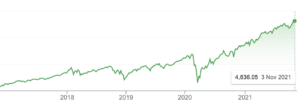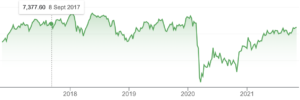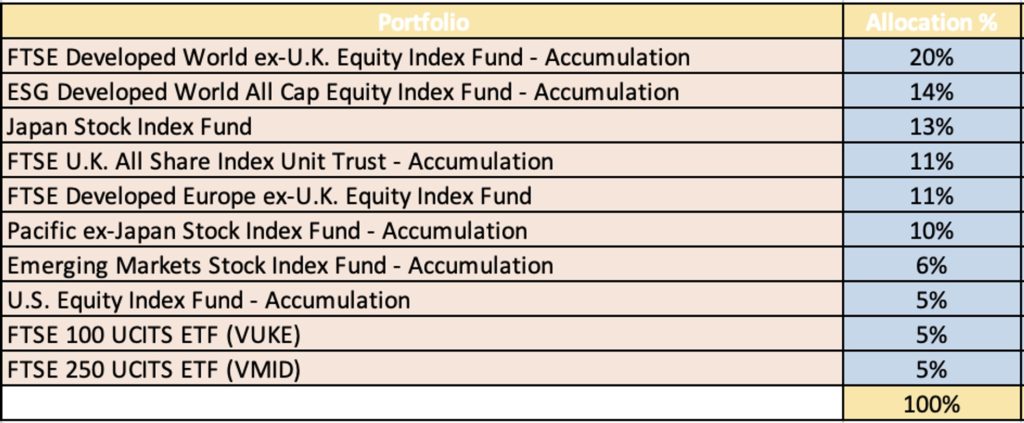How to invest in ETFs and all things passive can be relatively simple. It’s probably one of the easiest and cheapest ways to invest your money.
I’m going to go through some of the basics first and then look at ETFs and all things passive.

What Is Passive Investing?
Have you ever hoped for a way you could invest without having to check your investments daily, and all the jargon that comes along with having to buy and sell regularly?
Well Passive investing might be the solution, and it is much easier to get your head round when compared to Active investing.
With Passive Investing (a.k.a. Passives) you place your money into an investment with the idea that you aren’t going to change it too often, maybe once a year or once every 6 months.
It’s a buy and hold strategy with the long term in mind; compared to Active investing, where you are actively changing you’re investments daily, weekly or monthly.
There’s no manager who actively buys and sells to try and better the markets.
Index Tracking
The most common form of Passive investment is index tracking, your portfolio will mirror the performance of the index.
Passive investment is all about replication of the market index, and as the index goes up or down so will your money.
What’s an index?
An index is a form of measurement that tracks the performance of a group of assets, such as the FTSE 100 which holds the top 100 companies by market value in the UK. Indices are worldwide and range from the UK with the FTSE 100 to the U.S with the S&P 500.
Here’s an example:
Let’s say I invested £5,000 into an index fund that tracks the FTSE 100 and imagine today the FTSE 100 went up by 1%.
My £5,000 will also go up by 1%, which means today I would have made £50.
Equally, if the FTSE 100 goes down by 1% then I would have lost £50.
You can choose from thousands of index funds from all over the globe. You could track the U.S S&P 500, the French CAC 40 or the Nikkei 225 in Tokyo… so on and so on.
ETF’s All Round
Now we have a good understanding of Index Trackers we can now consider the ever popular ETF.
What’s an ETF?
An ETF stands for an ‘exchange traded fund’, and is a great way of tracking an index or a group of assets.
An ETF is traded on the stock market and so can be bought and sold in the same way individual stocks are.
ETF’s are used to track many types of investments, such as stocks, commodities, bonds, or property. There’s even a Cryptocurrency ETF that has recently been released, aimed to track the price of cryptocurrencies like Bitcoin.
There are ETF’s that will track the stock markets themselves as above but there are also ETF’s that track specific sectors, like tech or healthcare.
Where Should You start?
The concept of ETF’s and passive funds are actually quite simple. The complicated part comes with the amount of choice that’s available. There are thousands of ETF’s to choose from and it can feel like a minefield.
What and where do you want to invest?
Most people start investing in their largest home country market, so for me it’s the UK and the FTSE 100, then usually they add the S&P 500 in the US.
That’s all great and very good start, but it is only a start. Remember that passive investing is ideally a buy and hold strategy, and having very little diversification could mean you would have to intervene more often.
Diversification can be your best friend and will help prevent any big losses.
The U.S has done great recently I hear you say.
You would be correct, but who knows how long that might last!!!
Here is a chart I pulled off Google today showing the S&P over the last 5 years. What a growth story!

Here is the FTSE 100:

Other than the Covid-19 drop, the last 5 years has been pretty stagnant.
Here is the Hang Seng, Dollar dropping:

Not such a positive story with lots of ups and downs.
The markets are constantly changing and by investing in just one of them you risk either missing out on growth from one or being hit with a large downside on the other.
What Do I Do?
I’m not going to go through my reasonings on everything that I invest in – That’s probably enough for another whole post, but here is my current tracker portfolio of equities in use today:

I use a lot of Vanguard in the portfolio. The FTSE Developed world index funds are great as they are made up of index funds from developed world nations only, there will be the U.S, U.K, France, Germany etc etc.
Emerging Markets is made up of nations such as China, Taiwan, Korea & India. They are more risky as and so have a lower allocation in the overall portfolio.
My portfolio fits for me and what I want to invest in, and by how much I’m comfortable with in terms of risk.
Each of you will be different but I urge you to do something similar for your portfolio and keep it diverse.
Rebalancing
And lastly, rebalancing.
Rebalancing is a process of realigning the original allocation.
When prices go up or down the % of one of your index trackers will change. Rebalancing is where you sell the one that has gone up to bring it back in line and then add to the one that went down, again, to bring it back in line.
This keeps your portfolio risk the same throughout and doesn’t overexpose you to one market.
I tend to do this once every year, maybe every 6 months depending on what’s happening in the markets.
Advantages
- The costs are low at around 0.10% – 0.30% per year.
- You aren’t paying more in the hope that the manager will outperform (Charges could be around 1.2% per year).
- You will get the same performance as the market that is being tracked.
- A simple investing solution, that often works well with a long term buy and hold strategy, with very minimal involvement.
Disadvantages
- When markets go down so too will your portfolio by equal amounts.
- There’s no active management so you could miss out on better returns from a manager selecting specific assets for you.
Recap
And that’s it for today, here is a recap:
- Index trackers and ETF’s will aim to mirror an index or specific sectors.
- Trackers are ideal for a buy and hold strategy.
- There isn’t a fund manager trying to outperform the markets.
- An ETF is traded on a stock market.
- Diversify, diversify, diversify.
- Low trading costs and a simple way of investing your money.

